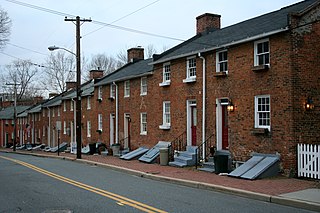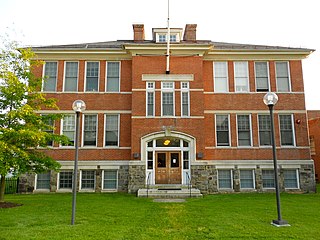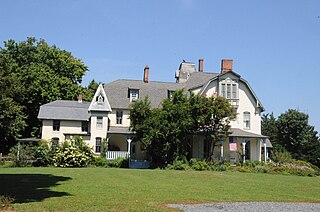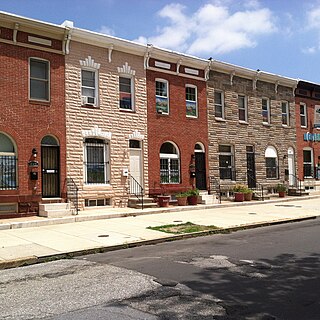
Oella is a mill town on the Patapsco River in western Baltimore County, Maryland, United States, located between Catonsville and Ellicott City. It is a 19th-century village of millworkers' homes.

Mount de Sales Academy is an all-girls secondary school located in Catonsville in unincorporated Baltimore County, Maryland. The school is located near the city of Baltimore and within the Roman Catholic Archdiocese of Baltimore.

The Craighill Channel Upper Range Rear Light is one of a pair of range lights that marks the second section of the shipping channel into Baltimore harbor.

Ashland is a historic home located in Upper Marlboro, Prince George's County, Maryland, United States. It is a 2+1⁄2-story, hip-roofed frame dwelling with fine Victorian Italianate decorative detail. It was built in 1866-1867 by William Beanes Hill of Compton Bassett for his son, William Murdock Hill. The house has been continuously associated with the prominent Hill family. Ashland is one of only a few significant frame dwellings of the Italianate style which survive in the county. It has a simple square floor plan, with cross gables in each plane of the hip roof. Also on the property are historic outbuildings.

St. Mary's Episcopal Church, also known as the Church of St. Mary the Virgin, is an historic rectangular-shaped Carpenter Gothic style Episcopal church located at 5610 Dogwood Road in Woodlawn, Baltimore County, Maryland. Designed by the Baltimore architectural firm of Dixon and Carson, it was built in 1873. Its steeply pitched gable roof, board and batten siding, lancet windows and arched side entry way are all typical features of Carpenter Gothic churches.

Brooklandville House, or the Valley Inn, is a historic restaurant and tavern building, and a former inn, located in Brooklandville, Baltimore County, Maryland. It is a 2+1⁄2-story stone structure facing the former railroad and dating from about 1832. It is associated with the Baltimore and Susquehanna Railroad, which crossed the property just to the south.

Brooklandwood, or Brookland Wood, is a historic home located in Brooklandville, Baltimore County, Maryland. Its grounds became developed for the St. Paul's School for Boys.

The Owings Upper Mill is a historic grist mill located at Owings Mills, Baltimore County, Maryland, United States. It is a large 3+1⁄2-story brick structure, 50 by 60 feet. The building stands on a low stone foundation, surmounted by a molded brick water table. Two frame extensions were built sometime in the 1880s. The words "EUREKA FLOUR MILL" are worked into the façade in purple brick between the second- and third-story windows. The building is probably the oldest and largest mill surviving in Baltimore County and was the last known project of Samuel Owings, the American Revolutionary War patriot and enterprising merchant.
The Nellie L. Byrd is a Chesapeake Bay skipjack, built in 1911 at Oriole, Maryland. She is a 53.6' long two-sail bateau, or "V"-bottomed deadrise type of centerboard sloop. She has a beam of 26.7', a depth of 4.8', and a net tonnage of 18 tons. She is one of the 35 surviving traditional Chesapeake Bay skipjacks and a member of the last commercial sailing fleet in the United States. When listed, she was located at Tilghman, Talbot County, Maryland. Since 2005, she is located at Middle River, Maryland, Baltimore County, Maryland.

Clifton School is a historic elementary school located at Baltimore, Maryland, United States. It is a late 19th-century school with an early 20th-century addition. The structure combines a gable-roofed, "T"-plan, brick county school built in 1882 with a Colonial Revival, flat-roofed, rectangular-plan, brick city school addition built in 1915.

Howard Park P.S. 218, also known as School 7, is a historic elementary school located at Baltimore, Maryland, United States. It is an early 20th-century brick school building located in the intact historic west Baltimore neighborhood of Howard Park. The earliest school building was constructed in 1908 and enlarged in 1913, 1936, and in 1957. The older sections are built of brick and accented with limestone details. It continued to function as a school until 1980.

Baltimore Grand is a historic bank building located at Baltimore, Maryland, United States. It occupies two historic bank buildings, the former Western National Bank and the former Eutaw Savings Bank, which were connected in 1989 and adaptively reused to create a commercial catering and banquet facility. It features a large arched window above the entrance portico that is framed by paired fluted pilasters with Corinthian capitals extending to the cornice line.

The Fifth Regiment Armory is a historic National Guard armory located in Baltimore, Maryland, United States. It is an imposing, fortress-type structure situated in midtown Baltimore. It consists of a full basement, a first floor containing a 200 foot by 300 foot drill hall, a mezzanine or "balcony" level, and a newer second level housing the trussed steel drill hall roof. The façade features buttresses, parapets, casement windows, and a crenellated roofline, giving the appearance of a medieval fortification. It was the site of the 1912 Democratic National Convention.

Douglass Place is a group of historic rowhouses located at Baltimore, Maryland, United States. Built in 1892, it represents typical "alley houses" of the period in Baltimore, two narrow bays wide, two stories high over a cellar, with shed roofs pitched to the rear. Italianate influence is reflected in their segmental-arched window and door openings, and in the simple molded sheet metal cornices which crown the buildings. Frederick Douglass (1818-1895) constructed the five buildings as rental housing for blacks in the Fells Point area of Baltimore, where he had resided from the 1820s to 1838. The site was the location of the Dallas Street Station Methodist Episcopal Church, which he had attended while living in the area.

Market Center is a national historic district in Baltimore, Maryland, United States. It is an approximately 24-block area in downtown Baltimore that includes buildings associated with the development of the area as Baltimore's historic retail district. The area evolved from an early 19th-century neighborhood of urban rowhouses to a premiere shopping district featuring large department stores, grand theaters, and major chain stores. The diverse size, style, scale, and types of structures within the district reflect its residential origins and evolution as a downtown retail center.

Lauretum is a historic home located at Chestertown, Kent County, Maryland, United States. It is a large, three story late Victorian stuccoed frame house built in 1881 for Chestertown lawyer Harrison W. Vickers (1845-1911). It features irregular massing, multiple roof forms, clipped gables, an oriel window, and exposed rafter ends. It was designed by Baltimore architect Edmund G. Lind (1829-1909).

Granite Historic District is a national historic district in Granite, Baltimore County, Maryland, United States. It comprises the focus of a rural quarrying community located in the Patapsco Valley of western Baltimore County, Maryland. It includes two churches, a school, a social hall, former commercial buildings, and houses and outbuildings, representing the period from the initial settlement of the area about 1750 through the early 20th century, when the village achieved its present form. The district also includes the former Waltersville quarry, one of two major granite operations in the region during the period. Granite from the Waltersville and Fox Rock quarries was utilized in construction of the Baltimore & Ohio Railroad in the 1830s, and later in such projects as the Library of Congress, old Treasury Building, and parts of the inner walls of the Washington Monument in Washington, D.C., and numerous other projects in Baltimore city and county.
Corbett Historic District is a national historic district at Monkton, Baltimore County, Maryland, United States. It is a group of 20 dwellings, a doctor's office, a former store/post office, a brothel, and a school comprising the village of Corbett in rural northern Baltimore County, Maryland. Most of the buildings date from about 1880 through about 1920. They reflect the period of Corbett's development as a stop on the Northern Central Railway, and a local commercial, industrial, and transportation center for the surrounding farms.

Winters Lane Historic District is a national historic district at Catonsville, Baltimore County, Maryland, United States. It is a historically African-American residential community which developed between 1867 and the mid-1940s. Winters Lane is located between Frederick Road and the Baltimore National Pike. It is composed mainly of single-family dwellings augmented by a few commercial, social, or religious resources. The district contains 155 properties, including 141 residential properties, two former schools, three commercial buildings, three social clubs, and five churches or church-related buildings.

East Monument Historic District or Little Bohemia, is a national historic district in Baltimore, Maryland. It is a large residential area with a commercial strip along East Monument Street. It comprises approximately 88 whole and partial blocks. The residential area is composed primarily of rowhomes that were developed, beginning in the 1870s, as housing for Baltimore's growing Bohemian (Czech) immigrant community. During the late 19th and early 20th centuries the neighborhood was the heart of the Bohemian community in Baltimore. The Bohemian National Parish of the Roman Catholic Church, St. Wenceslaus, is located in the neighborhood. The historic district includes all of McElderry Park and Milton-Montford, most of Middle East and Madison-Eastend, and parts of Ellwood Park.






















